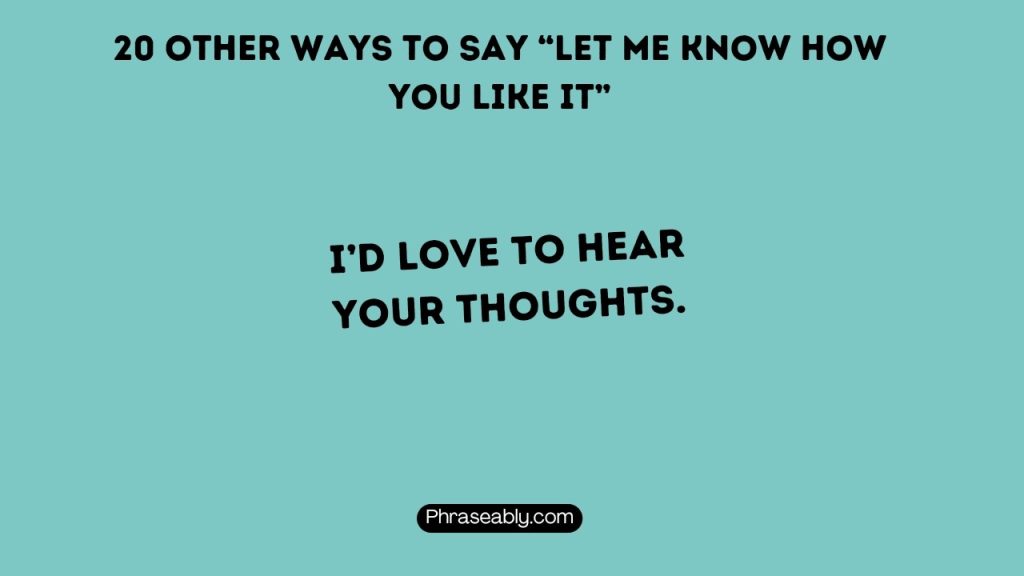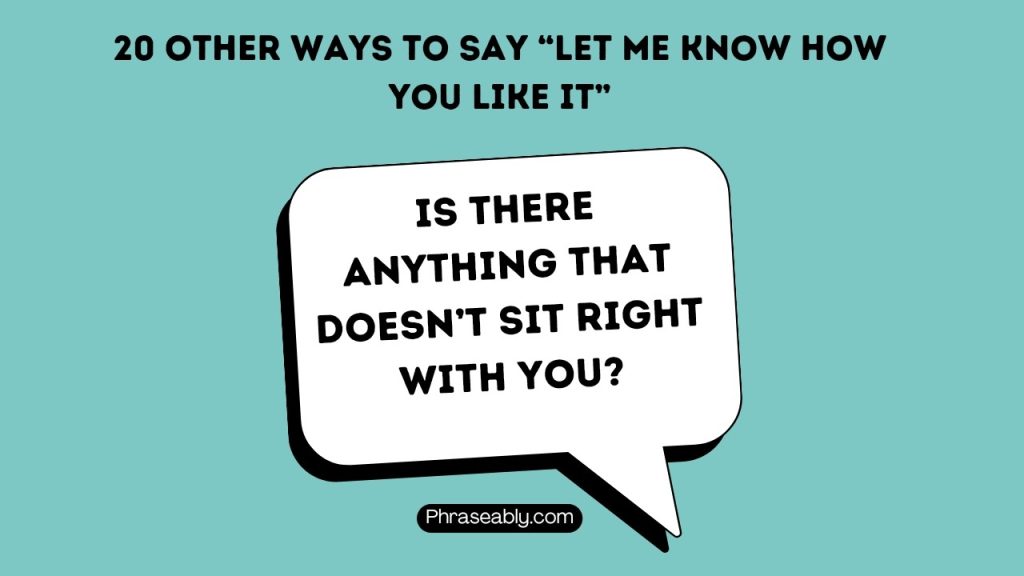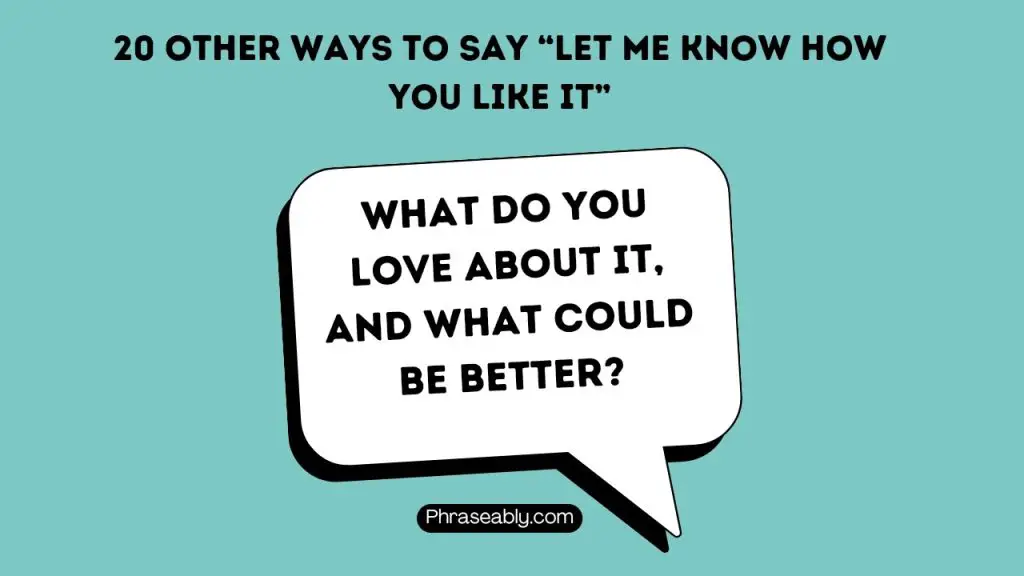Using the phrase “Let me know how you like it” is a common way to ask for someone’s opinion, but there are plenty of other engaging and subtle ways to express this sentiment.
Moreover, seeking feedback is an essential part of communication whether you’re sharing a project at work, giving a gift, or cooking dinner for a friend.
It is required of you to switch up your wordings, tailor your request to the situation, keep the conversation engaging, and even add a bit of flair to your communication style. This article will help you achieve that.
The beauty of asking for feedback is that it opens the door for meaningful conversation and invites the other person to be part of the experience.
Depending on the context, you might want to sound more professional, casual, or even humorous, in any case, having multiple options at your disposal allows you to pick the right expression for every occasion.
In this article, I’ve compiled 20 different ways to ask someone to share their thoughts or feelings about something you’ve created or shared.
Each phrase comes with two usage examples, and subcategories to illustrate how to utilize them for various settings.
Let’s dive in.
20 Other Ways to Say “Let Me Know How You Like It”
- I’d love to hear your thoughts.
- Let me know what you think.
- I’m curious to hear your perspective.
- Your feedback would mean a lot to me.
- I’d appreciate your honest opinion.
- What are your initial impressions?
- Does it resonate with you?
- What stands out to you the most?
- Do you see any room for improvement?
- Would you do anything differently?
- How does it feel to you?
- Do you think it works well?
- Is there anything that doesn’t sit right with you?
- What’s your gut feeling about it?
- Do you think it achieves the goal?
- How do you feel about the overall vibe?
- Does anything jump out at you?
- What do you love about it, and what could be better?
- Can you see this working out long-term?
- Is there anything you’d tweak or adjust?
1. I’d love to hear your thoughts.
This phrase is warm and inviting, making the other person feel that their opinion is valuable. It’s perfect for both professional and casual contexts and adds a touch of friendliness.
Example 1 (Professional):
- I just finished the draft of our project proposal. I’d love to hear your thoughts.
Example 2 (Casual):
- I tried a new recipe for this cake. I’d love to hear your thoughts on how it turned out.

It shows genuine interest in the other person’s opinion and invites them to share without feeling pressured.
2. Let me know what you think.
This is a direct and simple way to ask for feedback. It’s a classic go-to phrase that works in almost any situation and doesn’t require much explanation.
Example 1 (Professional):
- I’ve attached the latest version of the report. Let me know what you think.
Example 2 (Casual):
- Here’s the playlist I made for our road trip. Let me know what you think of the songs.
These phrases are straightforward and versatile and let the person know that their input matters.
3. I’m curious to hear your perspective.
This phrase adds a hint of curiosity, which can make the person feel that their unique viewpoint is particularly important. It’s excellent for creative or brainstorming situations.
Example 1 (Professional):
- We’re exploring new ideas for our campaign, and I’m curious to hear your perspective.
Example 2 (Casual):
- I just finished watching that movie you recommended. I’m curious to hear your perspective on it.
It’s a thoughtful way to ask for feedback, emphasizing that you value their individual insights.
4. Your feedback would mean a lot to me.
When you want to show that you genuinely care about what someone has to say, this phrase does the job. It adds a layer of sincerity and appreciation.
Example 1 (Professional):
- I put a lot of effort into this design, and your feedback would mean a lot to me.
Example 2 (Casual):
- I’ve been working on this song for a while. Your feedback would mean a lot to me.
It conveys a sense of vulnerability and the desire for honest input.
5. I’d appreciate your honest opinion.
This phrase is great when you want the person to feel comfortable sharing constructive criticism. It reassures them that honesty is not only welcome but also valued.
Example 1 (Professional):
- We’re trying to improve our customer service, so I’d appreciate your honest opinion on our current approach.
Example 2 (Casual):
- I wrote a short story, and I’d appreciate your honest opinion on it.
It encourages a more candid response, which can be really helpful for growth and improvement.
6. What are your initial impressions?
This phrase is perfect for situations where you want quick feedback. It makes the person feel that their immediate thoughts are valuable, even before a detailed review.
Example 1 (Professional):
- I’ve just presented the strategy outline. What are your initial impressions?
Example 2 (Casual):
- I rearranged the living room a bit. What are your initial impressions?
It’s an excellent way to get the conversation started and invite the person to share their reaction.
7. Does it resonate with you?
This expression is deeper and more reflective, often used for creative work or ideas. It implies that you’re interested in the emotional or intellectual impact of your work.
Example 1 (Professional):
- I’ve crafted this brand story. Does it resonate with you and the vision of the company?
Example 2 (Casual):
- I wrote this poem about our childhood memories. Does it resonate with you?
It invites a more introspective and thoughtful response, perfect for art, writing, or meaningful conversations.
8. What stands out to you the most?
This is an engaging way to direct the person’s attention to specific aspects of your work. It also makes it easier for them to provide focused feedback.
Example 1 (Professional):
- After reviewing the presentation, what stands out to you the most?
Example 2 (Casual):
- I decorated the cupcakes with a new icing technique. What stands out to you the most?
It’s a great way to discover which part of your work makes the strongest impression.
9. Do you see any room for improvement?
This phrase explicitly asks for constructive feedback. It’s especially useful when you’re looking to refine or perfect something and want the person to be honest about potential changes.
Example 1 (Professional):
- I’ve put together the quarterly report. Do you see any room for improvement?
Example 2 (Casual):
- I painted this landscape yesterday. Do you see any room for improvement in the details?
It’s a humble way to seek out suggestions and shows that you’re open to growth.
10. Would you do anything differently?
This question empowers the person to think creatively and share how they would approach your work. It’s a collaborative way to gather feedback and often leads to new ideas.
Example 1 (Professional):
- If you were in charge of this marketing plan, would you do anything differently?
Example 2 (Casual):
- I styled the garden with a mix of flowers. Would you do anything differently if it were your project?
Above examples are an engaging way to invite creative input and inspire collaboration.
11. How does it feel to you?
This expression focuses on the person’s overall experience or emotional reaction. It’s ideal for settings where feeling and intuition matter, such as creative or sensory projects.
Example 1 (Professional):
- I’ve drafted this user experience flow. How does it feel to you when you navigate through it?
Example 2 (Casual):
- I’ve arranged the furniture to create a cozy vibe. How does it feel to you when you walk into the room?
It’s a great way to make feedback feel more intuitive and less analytical.
12. Do you think it works well?
This phrase asks for a judgment about functionality or effectiveness. It’s a useful option when evaluating processes, designs, or solutions.
Example 1 (Professional):
- I implemented the new layout for our website. Do you think it works well for our users?
Example 2 (Casual):
- I tried pairing this jacket with these shoes. Do you think it works well as an outfit?
It invites practical, thoughtful responses about how something functions or fits together.
13. Is there anything that doesn’t sit right with you?

This is a slightly more personal way to ask if anything feels off or doesn’t quite work. It’s a respectful and open-ended way to invite concerns or criticisms.
Example 1 (Professional):
- I’ve written up our project summary. Is there anything that doesn’t sit right with you or needs revising?
Example 2 (Casual):
- I’ve cooked this new dish for dinner. Is there anything that doesn’t sit right with you flavor-wise?
The above examples allow the person to feel comfortable sharing potential issues.
14. What’s your gut feeling about it?
Trusting one’s instincts is valuable, and this phrase specifically seeks intuitive feedback. It’s great when you want a genuine, unfiltered reaction.
Example 1 (Professional):
- We’re considering this logo design for the brand. What’s your gut feeling about it?
Example 2 (Casual):
- I made a split-second decision to choose this movie. What’s your gut feeling about it from the trailer?
It’s perfect for situations where first impressions and intuition are important.
15. Do you think it achieves the goal?
This is a goal-oriented question, useful when you want feedback about whether something meets its intended purpose.
Example 1 (Professional):
- Our advertising campaign is focused on customer engagement. Do you think it achieves the goal?
Example 2 (Casual):
- I set up this game to keep the kids entertained. Do you think it achieves the goal?
It’s a direct way to get feedback on the effectiveness of your work.
16. How do you feel about the overall vibe?
This casual and engaging question invites the person to reflect on the general atmosphere or tone of something you’ve created.
Example 1 (Professional):
- I’ve revamped the office layout to be more open. How do you feel about the overall vibe?
Example 2 (Casual):
- I went for a bohemian theme in this room. How do you feel about the overall vibe?
In case you want to discuss interiors or aesthetics, above is a fun way to discuss aesthetics and mood.
17. Does anything jump out at you?
This question focuses on whether any aspect of your work stands out, for better or worse. It’s a great way to pinpoint elements that have a strong impact.
Example 1 (Professional):
- I redesigned the homepage with some new features. Does anything jump out at you immediately?
Example 2 (Casual):
- I painted a mural on this wall. Does anything jump out at you as striking or unusual?
It invites honest and often instinctive reactions.
18. What do you love about it, and what could be better?
This is a balanced way to get both positive and constructive feedback. It makes the person feel comfortable sharing both their praises and their concerns.
Example 1 (Professional):
- I completed the presentation slides. What do you love about it, and what could be better?
Example 2 (Casual):
- I made your favorite pasta dish but with a twist. What do you love about it, and what could be better?
It helps you understand what’s working and where there’s room for improvement.

19. Can you see this working out long-term?
This phrase invites a forward-thinking perspective, making the person consider sustainability or future impact.
Example 1 (Professional):
- We’re testing a new workflow. Can you see this working out long-term for the team?
Example 2 (Casual):
- I’ve started using these meal prep containers. Can you see this working out long-term for our busy schedule?
It’s perfect for getting feedback on projects or ideas that need to stand the test of time.
20. Is there anything you’d tweak or adjust?
This friendly, non-intimidating way of asking for feedback makes the person feel they have the freedom to suggest small or big changes.
Example 1 (Professional):
I’ve put together the final draft of our report. Is there anything you’d tweak or adjust?
Example 2 (Casual):
- I styled my hair differently today. Is there anything you’d tweak or adjust?
It shows you’re open to refinement and appreciate the other person’s eye for detail.
Conclusion
Seeking feedback is more than just a formality; it’s an opportunity to grow, improve, and deepen your connection with those around you.
Asking for opinions in a variety of interesting ways keeps your communication interesting and makes others feel appreciated.
The correct phrase can make all the difference, whether you are sharing something personal, working on a creative project together, or at work.
Therefore, try one of these options the next time you want to know what someone thinks of your work and give the feedback process a deeper meaning.

